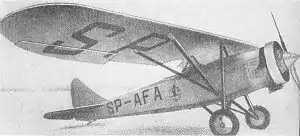Townend ring
A Townend ring is a narrow-chord cowling ring fitted around the cylinders of an aircraft radial engine to reduce drag and improve cooling.

Development
The Townend ring was the invention of Dr. Hubert Townend of the British National Physical Laboratory[1] in 1929. Patents were supported by Boulton & Paul Ltd in 1929.[2] In the United States it was often called a "drag ring". It caused a reduction in the drag of radial engines and was widely used in high-speed designs of 1930-1935 before the long-chord NACA cowling came into general use. Despite suggestions of it exploiting the Meredith effect, low airspeeds, low temperature differences and small mass flows make that unlikely,[3] particularly when combined with the lack of flow control as the air exits the cowling.[4] Although superior to earlier cowlings, and uncowled engines in terms of drag and cooling, above 217 kn (402 km/h; 250 mph) the NACA cowling was more efficient and soon replaced it in general use.[5]

Examples of aircraft with Townend rings include the Boeing P-26 Peashooter, the Vickers Wellesley, the Fokker D.XVI and the centre engine on the Junkers Ju 52/3m.[lower-roman 1]
Notes
- The wing engines of the Ju52 had longer NACA cowlings, but the centre engine only had space for the shorter Townend ring.
References
- Patent Specification 320131: Improvements in or relating to aircraft , 8 July 1933 (amended specification from original dated 10 July 1928)
- 1930 Canadian patent CA 304755 by Hubert Townend with drawings
- "A History of Aircraft Piston Engines" by Herschel Smith, (Sunflower University Press Manhattan, Kansas, 1981, ISBN 0-89745-079-5), 255pp.
- Becker, J.; The high-speed frontier: Case histories of four NACA programs, 1920- SP-445, NASA (1980), Chapter 5: High-speed Cowlings, Air Inlets and Outlets, and Internal-Flow Systems: The ramjet investigation
- Hansen, James R. "Engineering Science and the Development of the NACA Low-Drag Engine Cowling". From Engineering Science to Big Science: The NACA and NASA Collier Trophy Research Project Winners. Archived from the original on 2004-10-31. Retrieved 2007-04-28.
External links
| Wikimedia Commons has media related to Townend rings. |
- The Spotters Glossary
- North, J D (8 February 1934), "Engine Cowling: With Special Reference to the Air-cooled Engine", The Aircraft Engineer (Supplement to Flight), XXIV No. 6 (1311): 133–137
- North, J D (22 February 1934), "Engine Cowling", The Aircraft Engineer (Supplement to Flight), IX No. 2 (97): 174a–174f
- "Engine Cowling", Flight, XXVI No. 7 (1312): 157–158, 15 February 1934